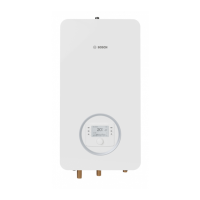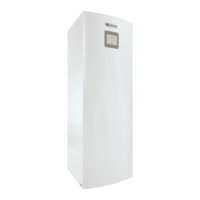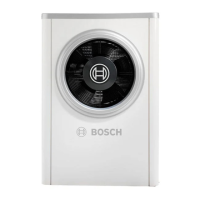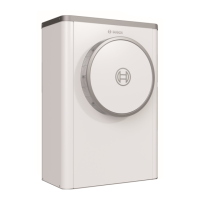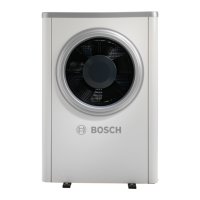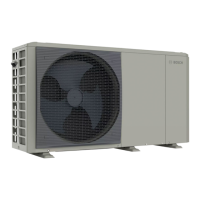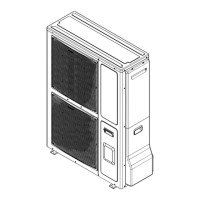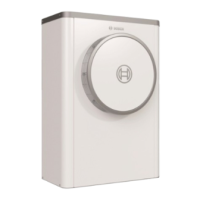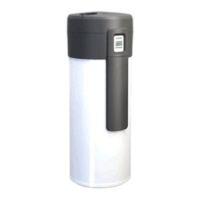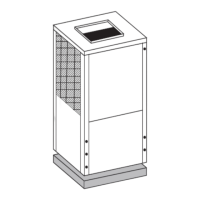Maintenance
31
Compress Hybrid 3400i AW – 6721861825 (2023/08)
8.6 Cooling mode
NOTICE
Damage to the indoor unit due to condensation
The indoor unit with mixer is not designed to be used in cooling mode
below the dew point.
▶ Only use the indoor unit in cooling mode above the dew point.
▶ Set the minimum set flow temperature to at least 17 °C.
▶ Make the necessary settings for cooling mode in the service menu
( instructions for control unit, Heating circuit settings section).
8.7 Adjusting the room temperature-dependent
controller
▶ Install the room temperature-dependent controller according to the
instructions (separate Installation and Operating Instructions).
▶ Set the room temperature-dependent controller as remote control Fb
(separate Installation and Operating Instructions).
▶ Set the room temperature-dependent controller as control unit for
heating circuit 1 (separate Installation and Operating
Instructions).
▶ Make the room temperature settings (separate Installation and
Operating Instructions).
9 Maintenance
WARNING
Danger to life from electric shock!
Touching live electrical parts can cause an electric shock.
▶ Before working on electrical parts, disconnect all phases of the
power supply of the entire heating system (fuse/miniature circuit
breaker) and secure to prevent unintentional reconnection.
NOTICE
Deformation due to heat!
If the temperature is too high, the insulation (EPP) in the indoor unit
deforms.
▶ When carrying out brazing work in the heat pump, protect the
insulation with a heat resistant cloth or damp cloth.
▶ Only use genuine spare parts!
▶ Refer to the spare parts list when ordering spare parts.
▶ Replace removed gaskets and O-rings with new ones.
The tasks described below must be carried out during an inspection.
Display activated alarm
▶ Check the alarm log (instructions for the control device).
General work
▶ Check that the heating system is generally in proper working order.
▶ Perform a visual inspection and function check of the heating system.
▶ Check all pipes for signs of corrosion and leaks.
▶ Replace any corroded pipework.
▶ Check the system for unusual noises.
▶ During the annual inspection, check the correct function of all
regulating, control and safety equipment and, where applicable, for
correct settings.
Function test
▶ Carry out function check ( Chap. 7.3).
9.1 Draining the heating system
The heating system must be drained when replacing hydraulic
components (e.g. DHW circulation pump) (Chapter 2.3).
▶ Interrupt the power supply to the outdoor unit, indoor unit and
external booster heater.
▶ Close all valves in the heating system.
▶ Close all automatic air vent valves in the heating system.
▶ Interrupt the flow at the particulate filter, close ball valve if necessary.
▶ Connect a hose to the drain valve of the heating system and route the
other end to a drain.
▶ Open the drain valve.
▶ Wait until no more water flows into the drain.
When water no longer flows, the indoor unit is empty.
9.2 Replacing components
▶ Interrupt the power supply to the outdoor unit, indoor unit and
external booster heater.
▶ Drain the heating system (Chapter 9.1).
▶ When replacing temperature sensors, make sure they are connected
correctly during installation (Fig. 9.2 and 49).
▶ Replace component (instructions for component).
▶ Fill and vent heating system (Chapter 7.1).
▶ Restore the power supply to the indoor and outdoor unit.
9.2.1 Replacing the pump
▶ Interrupt the power supply to the outdoor unit, indoor unit and
external booster heater.
▶ Drain the heating system (Chapter 9.1).
▶ Remove the hood (Chapter 5.3.1).
▶ Allow the system to cool and depressurise it.
▶ Pull off 2 plugs (power supply and signal) on the pump (Fig. 41).
▶ Remove the lock screw and pull the locking plate forwards and out
(Fig. 42).
NOTICE
Damaged and leaking connector pipes!
The screw fittings and connector pipes may be damaged if excessive
torques are applied when loosening and tightening the union nuts.
▶ Use a suitable tool.
▶ Counterhold at the coupling points.
▶ Perform the disassembly and assembly correctly.
▶ Undo union nuts at the pump then remove the pump and gaskets
(Fig. 43). As you do so, counterhold at the coupling points using a
suitable tool.
▶ Insert new pump with new gaskets and fit union nuts on the pump.
Tighten the union nuts by hand then use a tool to turn them by approx. ¼
revolution.
▶ Fit locking plate.
▶Connect cables.
▶ Fill and vent heating system (Chapter 7.1).
▶ Carry out tightness test.
▶ Restore the power supply to the indoor and outdoor unit.

